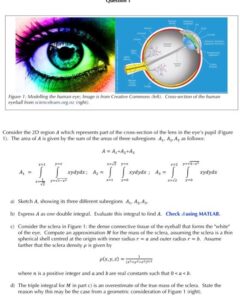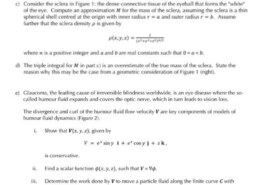Share
Consider the 2D region 𝐴 which represents part of the cross-section of the lens in the eye’s pupil (Figure 3). The area of 𝐴 is given by the sum of the areas of three subregions 𝐴", 𝐴!, 𝐴# as follows
ReportQuestion
Please briefly explain why you feel this question should be reported.
Consider the 2D region 𝐴 which represents part of the cross-section of the lens in the eye’s pupil (Figure
3). The area of 𝐴 is given by the sum of the areas of three subregions 𝐴”, 𝐴!, 𝐴# as follows:
𝐴 = 𝐴”+𝐴!+𝐴#
𝐴” = 2 2 𝑥𝑦𝑑𝑦𝑑𝑥
%&’
%&√”)’!
‘&”
‘& ”
√!
; 𝐴! = 2 2 𝑥𝑦𝑑𝑦𝑑𝑥
%&’
%&*
‘&√!
‘&”
; 𝐴# = 2 2 𝑥𝑦𝑑𝑦𝑑𝑥
%&√+)’!
%&*
‘&!
‘&√!
a) Sketch 𝐴, showing its three different subregions 𝐴”, 𝐴!, 𝐴#.
b) Express 𝐴 as one double integral. Evaluate this integral to find 𝐴. Check
A using MATLAB.
c) Consider the sclera in Figure 3: the dense connective tissue of the eyeball that forms the “white”
of the eye. Compute an approximation 𝑀 for the mass of the sclera, assuming the sclera is a thin
spherical shell centred at the origin with inner radius 𝑟 = 𝑎 and outer radius 𝑟 = 𝑏. Assume
further that the sclera density 𝜌 is given by
𝜌(𝑥, 𝑦, 𝑧) = ”
(‘!-%!-.!)”/!
where 𝑛 is a positive integer such that 𝑛 ≠ 3 and 0 < 𝑎 < 𝑏.
d) Glaucoma, the leading cause of irreversible blindness worldwide, is an eye disease where the so-
called humour fluid expands and covers the optic nerve, which in turn leads to vision loss.
The divergence and curl of the humour fluid flow velocity 𝑽 are key components of models of
humour fluid dynamics (Figure 4).
i. Show that 𝑽(𝑥, 𝑦, 𝑧), given by
𝑉 = ( 2𝑥𝑦𝑧# + 𝑦𝑒’% ) 𝐢 + ( 𝑥𝑒’% + 𝑥!𝑧#) 𝐣 + ( 3𝑥!𝑦 𝑧! + cos 𝑧 ) 𝐤 ,
is conservative.
ii. Find a scalar function 𝜙(𝑥, 𝑦, 𝑧), such that 𝑽 = ∇𝜙.
iii. Determine the work done by 𝑽 to move a particle fluid along the finite curve 𝑪 with
parametrization
𝐫(𝑡) = (𝑥(𝑡), 𝑦(𝑡), 𝑧(𝑡)) = (𝑡, 𝑡 sin 𝑡 , (𝑡 + 1) cos 𝑡), 0 ≤ 𝑡 ≤ 2𝜋.
Sketch 𝑪 using MATLAB.
iv. Find the divergence of a fluid velocity 𝑽, given
𝑽 = 𝑥𝑦!𝑧 𝐢 − 𝑥𝑧! 𝐣 + 𝑥!𝑦 𝐤.
State the values of x, y and z where the point (𝑥, 𝑦, 𝑧) is a sink of 𝑽.


Answers ( 2 )
Please briefly explain why you feel this answer should be reported.
Please briefly explain why you feel this answer should be reported.
One of our expert is on it will take some time to solve this question